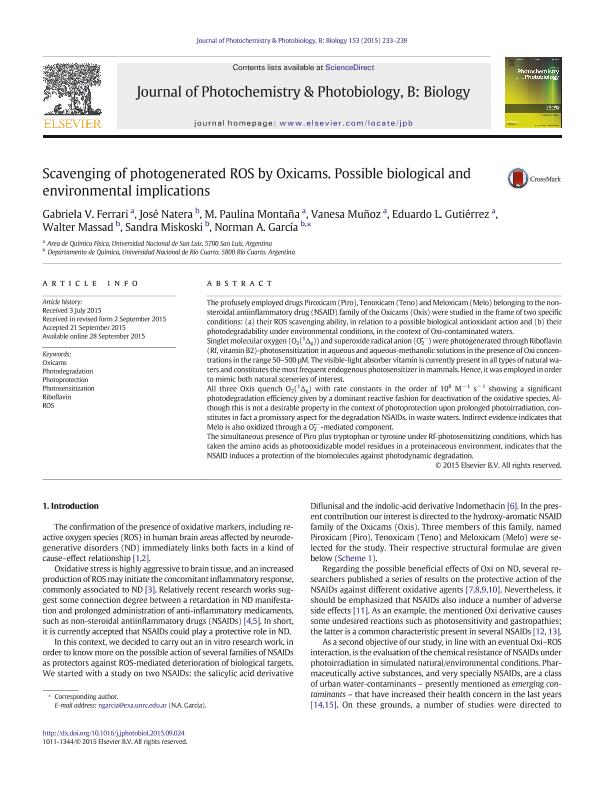Artículo
Scavenging of photogenerated ROS by Oxicams. Possible biological and environmental implications
Ferrari, Gabriela Verónica ; Natera, Jose Eduardo
; Natera, Jose Eduardo ; Montaña, Maria Paulina
; Montaña, Maria Paulina ; Muñoz, Vanesa Alejandra
; Muñoz, Vanesa Alejandra ; Gutiérrez, Eduardo Luciano
; Gutiérrez, Eduardo Luciano ; Massad, Walter Alfredo
; Massad, Walter Alfredo ; Miskoski, Sandra
; Miskoski, Sandra ; Garcia, Norman Andino
; Garcia, Norman Andino
 ; Natera, Jose Eduardo
; Natera, Jose Eduardo ; Montaña, Maria Paulina
; Montaña, Maria Paulina ; Muñoz, Vanesa Alejandra
; Muñoz, Vanesa Alejandra ; Gutiérrez, Eduardo Luciano
; Gutiérrez, Eduardo Luciano ; Massad, Walter Alfredo
; Massad, Walter Alfredo ; Miskoski, Sandra
; Miskoski, Sandra ; Garcia, Norman Andino
; Garcia, Norman Andino
Fecha de publicación:
28/12/2015
Editorial:
Elsevier Science Sa
Revista:
Journal of Photochemistry and Photobiology B: Biology
ISSN:
1011-1344
Idioma:
Inglés
Tipo de recurso:
Artículo publicado
Clasificación temática:
Resumen
The profusely employed drugs Piroxicam (Piro), Tenoxicam (Teno) and Meloxicam (Melo) belonging to the non-steroidal antiinflammatory drug (NSAID) family of the Oxicams (Oxis) were studied in the frame of two specific conditions: (a) their ROS scavenging ability, in relation to a possible biological antioxidant action and (b) their photodegradability under environmental conditions, in the context of Oxi-contaminated waters. Singlet molecular oxygen (O2(1Δg)) and superoxide radical anion (O2 -) were photogenerated through Riboflavin (Rf, vitamin B2)-photosensitization in aqueous and aqueous-methanolic solutions in the presence of Oxi concentrations in the range 50-500 μM. The visible-light absorber vitamin is currently present in all types of natural waters and constitutes the most frequent endogenous photosensitizer in mammals. Hence, it was employed in order to mimic both natural sceneries of interest. All three Oxis quench O2(1Δg) with rate constants in the order of 108 M- 1 s- 1 showing a significant photodegradation efficiency given by a dominant reactive fashion for deactivation of the oxidative species. Although this is not a desirable property in the context of photoprotection upon prolonged photoirradiation, constitutes in fact a promissory aspect for the degradation NSAIDs, in waste waters. Indirect evidence indicates that Melo is also oxidized through a O2 --mediated component. The simultaneous presence of Piro plus tryptophan or tyrosine under Rf-photosensitizing conditions, which has taken the amino acids as photooxidizable model residues in a proteinaceous environment, indicates that the NSAID induces a protection of the biomolecules against photodynamic degradation.
Palabras clave:
Oxicams
,
Photodegradation
,
Photoprotection
,
Photosensitization
,
Riboflavin
,
Ros
Archivos asociados
Licencia
Identificadores
Colecciones
Articulos(CCT - CORDOBA)
Articulos de CTRO.CIENTIFICO TECNOL.CONICET - CORDOBA
Articulos de CTRO.CIENTIFICO TECNOL.CONICET - CORDOBA
Citación
Ferrari, Gabriela Verónica; Natera, Jose Eduardo; Montaña, Maria Paulina; Muñoz, Vanesa Alejandra; Gutiérrez, Eduardo Luciano; et al.; Scavenging of photogenerated ROS by Oxicams. Possible biological and environmental implications; Elsevier Science Sa; Journal of Photochemistry and Photobiology B: Biology; 153; 28-12-2015; 233-239
Compartir
Altmétricas



